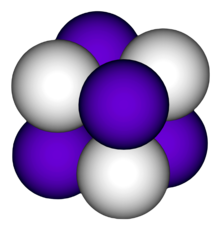 Potassium cation, K+ Hydrogen anion, H− | |
| Names | |
|---|---|
| IUPAC name
Potassium hydride
| |
| Identifiers | |
3D model (JSmol)
|
|
| ChemSpider | |
| ECHA InfoCard | 100.028.823 |
| EC Number |
|
PubChem CID
|
|
CompTox Dashboard (EPA)
|
|
| |
| |
| Properties | |
| KH | |
| Molar mass | 40.1062 g/mol |
| Appearance | white to gray crystalline powder |
| Density | 1.43 g/cm3[1] |
| Melting point | decomposes at ~400 °C[2] |
| reacts | |
| Solubility | insoluble in benzene, diethyl ether, carbon disulfide |
| Structure | |
| cubic, cF8 | |
| Fm3m, No. 225 | |
| Thermochemistry | |
Heat capacity (C)
|
37.91 J/(mol⋅K) |
Std enthalpy of
formation (ΔfH⦵298) |
-57.82 kJ/mol |
| Hazards | |
| Occupational safety and health (OHS/OSH): | |
Main hazards
|
corrosive, pyrophoric, reacts violently with acids and water |
| NFPA 704 (fire diamond) | |
| Related compounds | |
Other cations
|
Lithium hydride Sodium hydride Rubidium hydride Caesium hydride |
Except where otherwise noted, data are given for materials in their standard state (at 25 °C [77 °F], 100 kPa).
| |
Potassium hydride, KH, is the inorganic compound of potassium and hydrogen. It is an alkali metal hydride. It is a white solid, although commercial samples appear gray. It is a powerful superbase that is useful in organic synthesis. It is sold commercially as a slurry (~35%) in mineral oil or sometimes paraffin wax to facilitate dispensing.[3]
- ^ Robert E. Gawley, Xiaojie Zhang, Qunzhao Wang, "Potassium Hydride" Encyclopedia of Reagents for Organic Synthesis 2007 John Wiley & Sons. doi:10.1002/047084289X.rp223.pub2
- ^ David Arthur Johnson; Open University (12 August 2002). Metals and chemical change. Royal Society of Chemistry. pp. 167–. ISBN 978-0-85404-665-2. Retrieved 1 November 2011.
- ^ Douglass F. Taber, Christopher G. Nelson (2006). "Potassium Hydride in Paraffin: A Useful Base for Organic Synthesis". J. Org. Chem. 71 (23): 8973–8974. doi:10.1021/jo061420v. PMC 3248818. PMID 17081034.
